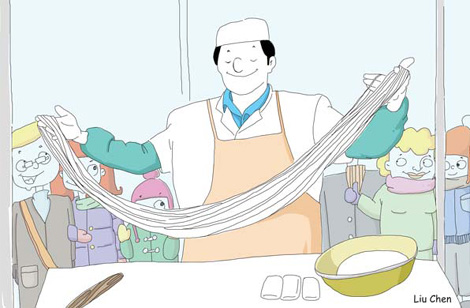Comment
In praise of Chinese noodles
By Linda Gibson (China Daily)
Updated: 2010-01-11 09:10
 |
Large Medium Small |

Like many Americans, I came to Beijing with the mistaken notion that noodles are a simple food.
My upbringing didn't offer much contact with noodles. We ate potatoes at almost every meal, in every conceivable form, but noodles were a rarity.
Italian-American neighborhoods ate them as pasta. German-Americans enjoyed them as spaetzle. Both varieties have noble histories of hand-made glory.
In my house, though, they were convenience food accessed by a can opener. They'd come slithering out as SpaghettiOs or chicken noodle soup. Both were made by a company named Campbell, whose red-and-white cans were staples on every American kitchen shelf.
A Campbell's can even became the subject of a famous Andy Warhol painting, elevating that humble container to high art. Too bad he couldn't do the same for the stuff within.
The canned product in no way prepared me for the fact that noodles appear in cultures worldwide as some of their signature dishes.
They range across countries, adapting to local tastes as Noodles Romanoff here or Noodle Kugel there, sopping up sauces and mingling with meats, cheese, seafood and produce with indiscriminate pleasure.
As befits their long history, the Chinese have raised noodle-making to an art form with the hand-pulled noodle.
Most likely, Beijingers know how much time and practice it takes to make hand-pulled noodles. But it surprised this Campbells-weaned Westerner, who observed the process at a Beijing Niudawan 24-hour noodle shop that had a big window on the cooks in action.
Learning to make hand-pulled noodles takes months. Much dough never makes it to the noodle stage.
The trickiest part is the task of pulling the dough at the right time and with the proper amount of speed. This is the step where beginners most often falter, ripping the dough to shreds instead of pulling it into noodles.
If you can watch someone who has mastered this, you'll see quite a show. There ought to be plenty of opportunities during the Spring Festival, when families will include Long-Life Noodles in their holiday meals.
From a lump of dough about the size of an infant, the cook eventually conjures a quantity of long, slender strands. This takes a lot of vigorous interaction between cook and dough.
The cook's entire upper-body structure - hands, arms, shoulders, back - are enlisted in the endeavor.
Like a sculptor working on a hunk of marble, the cook approaches his material with techniques that start broad and blunt, then narrow to small refinements. With dough in hand on a counter, he kneads, folds, rolls, kneads again, pats flat, folds, and rolls until it's time to raise it in the air and pull, twist and hang, pull, twist and hang.
Sometimes during this intense massage, the cook grabs it with both hands and slams it down on the wood counter. Becoming noodles is not for sissy pastries.
Finally, when his fingers tell him that gravity, manipulation and slamming have brought the dough to just the right consistency, the cook begins the final act in the show.
One hand anchors an end firmly to the counter while the other, fingers sunk into the dough, pulls it away into long strands. Bringing his hands back together, these are quickly doubled up, held down and finger-raked again and again and again.
When the strands quivering between his outstretched arms reach the right size, he gives them one last whack against the counter, trims the ends and tosses them into a gigantic pot of boiling water.
What comes out are noodles. Simple noodles.










